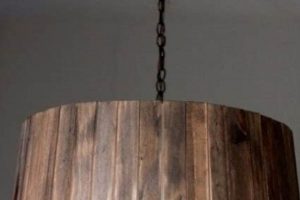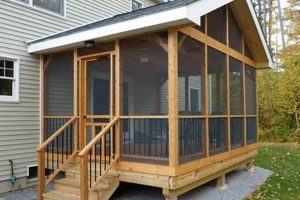The concept involves creating a designated space within a home or facility using readily available materials and techniques to stimulate an individual’s senses. These spaces are designed to provide opportunities for individuals, especially those with sensory processing disorders, autism spectrum disorder, or other developmental disabilities, to engage with textures, lights, sounds, and movements in a controlled and therapeutic environment. A practical instance might involve constructing a bubble wall using a repurposed aquarium, incorporating textured wall panels with varied fabrics, and installing color-changing LED lighting to foster a calming atmosphere.
The significance of these environments lies in their potential to promote relaxation, reduce anxiety, and enhance cognitive development. Historically, the creation of sensory rooms has been confined to professional settings like therapy centers or specialized schools. However, the democratization of information and affordability of relevant materials have empowered individuals and families to construct their own tailored sensory spaces. This shift provides consistent and personalized sensory input accessible at any time, leading to improved emotional regulation and self-soothing capabilities.
The subsequent discussion will explore the various facets involved in establishing a customized environment. This includes material selection, considerations for lighting and sound, and strategies for maximizing the therapeutic impact of the space, all while adhering to safety guidelines. Furthermore, the creation and use of such spaces will consider individualized needs, adapting the rooms to provide unique sensory experiences and comfort.
Implementation Strategies for Creating Individualized Sensory Spaces
The following are key considerations when establishing a home-based sensory environment. These strategies focus on adaptability and practicality to ensure the space meets the specific needs of its intended user.
Tip 1: Prioritize Safety. All materials used in the sensory room should be non-toxic, durable, and easily cleaned. Secure all fixtures and equipment to prevent accidents or injuries. Regularly inspect the space for potential hazards.
Tip 2: Control Lighting Options. Incorporate dimmable lighting or color-changing LED strips to provide a range of visual stimuli. Avoid harsh fluorescent lighting, which can be overstimulating. Consider using blackout curtains to control external light sources.
Tip 3: Manage Auditory Input. Integrate sound-dampening materials like acoustic panels or thick rugs to reduce background noise. Offer a selection of calming soundscapes, such as nature sounds or white noise, accessible through headphones or a low-volume speaker system.
Tip 4: Introduce Tactile Elements. Incorporate a variety of textures, such as soft blankets, textured wall panels, or weighted items, to provide tactile input. Ensure materials are appropriate for the individuals sensory preferences and sensitivities. Consider a sand tray or water beads.
Tip 5: Integrate Movement Opportunities. A rocking chair, beanbag, or mini trampoline can provide vestibular input. Ensure the space allows for safe and unrestricted movement. A balance beam can be useful for older children.
Tip 6: Personalize the Environment. Tailor the sensory room to the individual’s specific needs and preferences. Observe their reactions to different stimuli and adjust the environment accordingly. Involve the individual in the design and selection of materials where possible.
Tip 7: Establish a Routine. Integrate the use of the sensory space into a daily routine to promote predictability and consistency. This can help the individual anticipate and regulate their sensory experiences.
Careful planning and consistent implementation of these tactics contribute to the effectiveness of a sensory space for promoting relaxation, focus, and overall well-being.
The subsequent section will delve into specific material selections and their potential benefits, along with strategies for continuous assessment and adaptation of the sensory environment.
1. Space Optimization
The strategic use of available space is fundamental to the success of constructing personalized sensory environments. A well-optimized space enhances the therapeutic potential and functionality of the area, irrespective of its size. Careful planning ensures that the constructed environment effectively addresses the specific sensory needs of the user while remaining practical and accessible.
- Functional Zoning
Dividing the area into distinct zones based on sensory stimulation type (e.g., a calming corner, an active play zone) maximizes usability. This categorization facilitates focused engagement and prevents sensory overload by enabling users to navigate to areas best suited to their current needs. For example, a designated quiet corner featuring dim lighting and soft textures can offer a respite from a more active zone with brightly colored objects and movement-based equipment.
- Vertical Utilization
Exploiting vertical space is crucial in smaller areas. Wall-mounted features such as bubble panels, textured boards, or shelving for sensory objects can provide stimulation without consuming valuable floor space. This approach not only conserves area but also encourages visual tracking and exploration, catering to both visual and tactile sensory needs.
- Multifunctional Elements
Selecting elements that serve multiple purposes increases efficiency. A storage ottoman, for example, can provide seating while also housing sensory toys. A platform with a built-in vibration function can serve as both a seating area and a source of tactile stimulation. Such versatile components make the most of limited spaces and reduce clutter.
- Accessibility and Flow
Ensuring clear pathways and easy access to all areas of the sensory environment is vital. The layout should promote independent navigation and prevent obstacles that might hinder movement or cause frustration. Considering the individual’s physical abilities and any mobility aids they may use is essential for creating a truly inclusive space.
The facets of effective space optimization are essential when constructing personalized sensory environments. By carefully considering zoning, vertical utilization, multifunctional elements, and accessibility, the constructed environment effectively addresses the specific sensory needs of the user while remaining practical and accessible, regardless of the spaces physical dimensions.
2. Budget Allocation
Budget allocation represents a critical determinant in the realization of customized sensory environments. The financial resources dedicated to the project influence th
e scope, quality, and sustainability of the space. Strategic financial planning is essential to maximize the therapeutic potential within defined economic constraints.
- Material Selection and Cost-Effectiveness
Material selection directly impacts the overall expense. Opting for durable, low-cost materials like repurposed items or cost-effective textiles can significantly reduce project expenses without compromising functionality. For example, using recycled PVC pipes to create a light-up sensory wall, or utilizing inexpensive fleece blankets for tactile stimulation, provides functional alternatives to more costly commercial options. This approach emphasizes resourcefulness in crafting the environment.
- Prioritization of Sensory Modalities
Limited budgets necessitate prioritization of sensory modalities based on the individual’s needs. Identifying the most critical sensory inputs and allocating resources accordingly ensures the most impactful elements are addressed. If tactile stimulation is paramount, investing in a high-quality weighted blanket may be more beneficial than incorporating an elaborate sound system. This strategic distribution of funds maximizes therapeutic benefit within financial limitations.
- Phased Implementation
A phased implementation approach allows for gradual development as funds become available. Starting with essential elements and adding supplementary features over time distributes the financial burden. This method allows for continual improvement and refinement of the space based on ongoing observation and feedback. Initial stages may focus on safety and basic sensory provisions, with subsequent phases incorporating more specialized equipment or features.
- Maintenance and Replacement Costs
Budgetary considerations extend beyond initial construction to encompass maintenance and replacement costs. Selecting durable, easily maintained materials minimizes long-term expenditures. This proactive approach ensures the sustainability of the sensory environment and avoids unexpected financial strain. Choosing LED lighting over incandescent options, for example, reduces energy consumption and replacement frequency.
The interplay between financial planning and implementation defines the practical feasibility of customized sensory spaces. Strategic allocation, material prioritization, and phased development, alongside considerations for long-term maintenance, ensure the creation of effective therapeutic environments, irrespective of budget limitations. The careful consideration and implementation of these facets is essential for maximizing value and impact.
3. Sensory Modalities
Sensory modalitiesvisual, auditory, tactile, olfactory, gustatory, proprioceptive, and vestibularserve as the foundational elements within independently constructed sensory environments. The careful selection and integration of stimuli targeting these modalities directly influence the therapeutic efficacy of a sensory room. Omission or inappropriate application of sensory input can reduce effectiveness or, in certain instances, induce adverse reactions. For example, incorporating bright, rapidly flashing lights within a sensory room intended for calming may inadvertently trigger anxiety or seizures in photosensitive individuals. Therefore, the design and implementation of these rooms necessitates a comprehensive understanding of individual sensory profiles and sensitivities.
Effective application hinges on thoughtful combination and calibration of various sensory inputs. A practical example involves pairing calming visual stimuli, such as a slowly rotating projector displaying nature scenes, with gentle auditory input like ambient nature sounds. The addition of a weighted blanket offers tactile grounding, creating a multi-sensory experience designed to reduce anxiety and promote relaxation. Alternatively, a space designed to stimulate engagement might feature a variety of textured surfaces for tactile exploration, combined with interactive light displays and opportunities for controlled movement, such as a small trampoline or balance beam. Understanding how these modalities interact and influence one another is vital to crafting a holistic and beneficial environment.
In summation, sensory modalities represent indispensable components of successful sensory room design. Their judicious application requires a nuanced understanding of individual needs and a commitment to safety. Balancing diverse sensory inputs to create cohesive and therapeutic environments poses a continuous challenge. However, when executed effectively, these modalities offer significant benefits for individuals with sensory processing disorders, autism, and other conditions, empowering them to regulate their sensory experiences and improve overall well-being.
4. Personalization
Personalization constitutes a cornerstone in the effective implementation of independently constructed sensory environments. The degree to which a sensory room is tailored to the individual’s specific needs and preferences directly influences its therapeutic value and overall usability. Failure to prioritize personalization can result in an environment that is underutilized or, in some instances, counterproductive.
- Sensory Profile Alignment
The process of personalization should commence with a thorough assessment of the individual’s sensory profile. This assessment identifies specific sensitivities, preferences, and aversions across all sensory modalities. For instance, an individual with auditory sensitivities might require sound-dampening materials and minimal use of high-frequency sounds, whereas an individual seeking tactile stimulation may benefit from varied textures and weighted items. This alignment forms the foundation for informed material selection and design choices.
- Preference-Driven Aesthetics
The aesthetic elements of the sensory room, including color schemes, patterns, and overall design, should reflect the individual’s preferences. A room designed with preferred colors and themes promotes a sense of ownership and comfort, which encourages engagement and reduces anxiety. Involving the individual in the design process, when appropriate, further reinforces this sense of agency and enhances the therapeutic value of the space.
- Adaptive Functionality
The functional components of the sensory room should be adaptable to the individual’s changing needs and abilities. Adjustable lighting, modular furniture, and easily accessible storage solutions facilitate customization and modification over time. This adaptability ensures that the space remains relevant and beneficial as the individual’s sensory needs evolve.
- Integration of Personal Objects
Incorporating personal objects, such as familiar toys, photographs, or comforting items, can enhance the individual’s sense of connection to the sensory room. These items provide a sense of security and familiarity, making the space feel more inviting and less clinical. The presence of these objects can also facilitate emotional regulation and reduce feelings of isolation.
The successful incorporation of personalized elements is fundamental to the creation of effective independently constructed sensory environments. By prioritizing sensory profile alignment, preference-driven a
esthetics, adaptive functionality, and the integration of personal objects, the resulting space is tailored to the specific needs of the user, maximizing its therapeutic potential and promoting long-term usability. Overlooking these factors can result in a space that fails to meet the individual’s needs and diminishes its overall value.
5. Safety Standards
Adherence to established safety standards is paramount when constructing sensory environments. The inherent purpose of a sensory space is to provide a therapeutic environment; however, improperly implemented elements can introduce hazards and compromise the well-being of the user. Therefore, comprehensive safety protocols must underpin every stage of planning and execution.
- Material Toxicity
Material selection must prioritize non-toxic and hypoallergenic options. The use of paints, adhesives, and fabrics containing volatile organic compounds (VOCs) or allergenic substances poses significant health risks, particularly for individuals with sensory sensitivities or respiratory conditions. Prioritizing certified non-toxic materials and thoroughly ventilating the space during and after construction mitigates these risks. Example: Using solid wood furniture, which does not off-gas like particle board furniture, may be advantageous to help ensure safety.
- Structural Integrity
All fixtures, equipment, and furnishings must be securely anchored to prevent falls, collapses, or other structural failures. Wall-mounted features require appropriate load-bearing supports, and freestanding structures must exhibit sufficient stability. Regular inspections and maintenance are essential to identify and address any potential structural weaknesses. Improper anchoring can create hazards for vulnerable users with impaired mobility.
- Electrical Safety
Electrical components, including lighting systems, sound systems, and powered sensory equipment, must adhere to relevant electrical safety codes. Ground fault circuit interrupters (GFCIs) should be installed to prevent electrical shocks. All wiring must be properly insulated and protected from damage. Overloaded circuits and improperly grounded equipment present significant fire and shock hazards.
- Accessibility and Hazard Mitigation
The sensory environment should be designed to be fully accessible to the intended user, accommodating any mobility aids or physical limitations. Clear pathways, appropriate turning radii, and accessible storage solutions enhance usability. Sharp edges, protruding objects, and tripping hazards must be eliminated to minimize the risk of injury. Example: Using rounded corners on furniture can reduce the risk of injury.
In summary, rigorous adherence to safety standards is indispensable when creating sensory spaces. Diligent material selection, robust structural integrity, adherence to electrical safety codes, and proactive hazard mitigation are essential to ensure that the environment fulfills its therapeutic purpose without compromising the user’s safety. Neglecting these aspects undermines the benefits of the sensory room and introduces unacceptable risks.
6. Adaptability
Adaptability is an intrinsic characteristic of effectively constructed sensory environments. The sensory needs of individuals, particularly those with sensory processing disorders or developmental disabilities, are not static. These needs evolve over time due to maturation, therapeutic interventions, and changes in environmental factors. Consequently, a sensory space that lacks adaptability becomes quickly obsolete, diminishing its long-term therapeutic value. The efficacy of a sensory room directly correlates with its capacity to be modified, reconfigured, and updated to accommodate these shifting needs. For example, a child who initially benefits from high levels of tactile stimulation may, over time, develop a greater sensitivity to certain textures. A room that can be easily adjusted to reduce or eliminate these textures remains a valuable resource, while a static environment may become a source of distress.
The application of “diy sensory room ideas” inherently promotes adaptability. Unlike commercially produced sensory rooms that often feature fixed configurations and limited customization options, these offer the flexibility to integrate new elements, reconfigure existing components, and personalize the space to an individual’s evolving requirements. A simple example is the use of modular furniture, which allows for the easy rearrangement of the space to accommodate changes in mobility or activity preferences. Similarly, the incorporation of adjustable lighting systems allows for the fine-tuning of visual stimuli to address varying levels of sensitivity. The key lies in proactive assessment and responsive modification to align the environment with the current sensory profile of the user.
In summary, adaptability represents a fundamental design principle when crafting independently constructed sensory environments. The capacity to modify and update the space in response to changing sensory needs is paramount for ensuring its continued effectiveness. “diy sensory room ideas” afford the inherent flexibility required to achieve this level of adaptability, making them a more sustainable and beneficial alternative to static, commercially produced environments. Failure to prioritize adaptability undermines the long-term therapeutic potential, rendering the space less effective and potentially detrimental.
Frequently Asked Questions Regarding Independently Constructed Sensory Environments
This section addresses prevalent inquiries concerning the design, implementation, and maintenance of customized sensory spaces.
Question 1: Is specialized expertise required to develop an effective sensory room?
While professional consultation can be beneficial, the development of a functional sensory room does not mandate specialized expertise. A thorough understanding of the user’s sensory profile, coupled with adherence to safety guidelines, is paramount. Resources are available to inform material selection and design strategies.
Question 2: What constitutes the most critical element within a sensory room environment?
Personalization represents the most critical element. A sensory room must be tailored to the specific sensory needs, preferences, and aversions of the intended user. Generic sensory spaces may prove ineffective or, in some instances, detrimental.
Question 3: How can one effectively manage budgetary constraints when constructing a sensory room?
Strategic material selection, prioritization of essential sensory modalities, and phased implementation offer effective strategies for managing budgetary constraints. Repurposing existing materials and focusing on the most impactful sensory elements can optimize resource allocation.
Question 4: What are the primary safety considerations when implementing lighting within a sensory room?
Lighting systems must prioritize adjustability to accommodate varying sensitivities. Dimmable lighting, color-changing LEDs, and blackout curtains allow for precise control over visual stimulation. Harsh fluorescent lighting should be avoided due to its potential to induce sensory overload.
Question 5: How frequently s
hould a sensory room environment be re-evaluated and adapted?
Sensory needs evolve over time; therefore, regular re-evaluation is essential. A sensory room should be assessed and adapted at least quarterly, or more frequently if significant changes in the user’s behavior or sensory profile are observed. This ensures continued effectiveness and relevance.
Question 6: Are specialized cleaning protocols necessary for maintaining a sensory room?
The cleaning protocols should align with the types of materials used. Non-toxic cleaning agents are essential. Regular cleaning schedules should be implemented to minimize the accumulation of dust, allergens, and pathogens, thereby promoting a safe and hygienic environment.
The effectiveness of a independently constructed sensory environments relies heavily on personalized adaptation and adherence to safety regulations.
The subsequent section will delve into case studies illustrating successful implementation.
Conclusion
The exploration of independently constructed sensory spaces reveals a spectrum of considerations, from initial planning to ongoing adaptation. Strategic resource allocation, informed material selection, and meticulous attention to safety protocols represent essential components in fostering a therapeutic environment. These elements are paramount in transforming an ordinary space into a sensory-rich environment that can positively influence well-being and development. This undertaking demands vigilance, creativity, and, above all, a commitment to addressing individual sensory needs.
The continued advancement and refinement of independently constructed sensory environments offer promising avenues for enhancing the lives of individuals with sensory processing differences. As understanding deepens and resources become increasingly accessible, the potential to create impactful and personalized sensory solutions will further expand. A continued focus on innovation, coupled with a commitment to individual well-being, will unlock new frontiers in sensory integration and therapeutic support.



![Creative DIY Mobile Home Skirting Ideas [Guide] The DIY Hub: Creative Crafts, Repairs & Life Hacks Creative DIY Mobile Home Skirting Ideas [Guide] | The DIY Hub: Creative Crafts, Repairs & Life Hacks](https://craftingdiycenter.com/wp-content/uploads/2025/07/th-4605-300x200.jpg)



